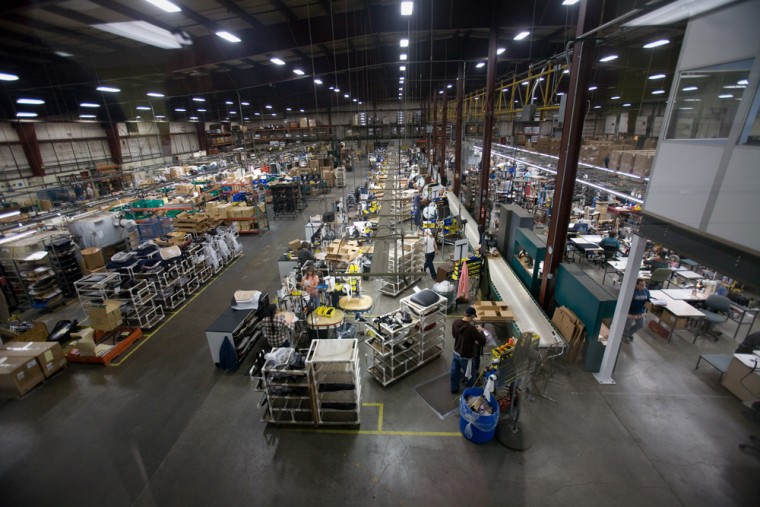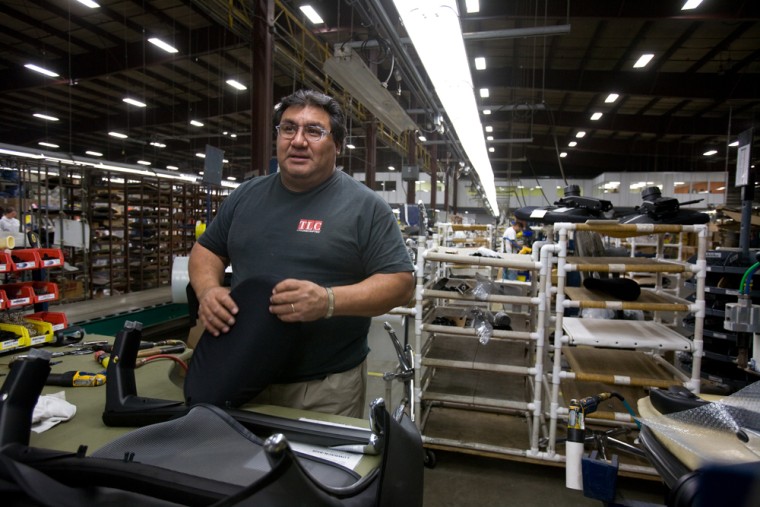In hard-hit Elkhart, Ind., there are glimmers of economic hope as some recreational vehicle makers and other companies have begun hiring again after a long downturn.
But with the county jobless rate still well above the national average at 15 percent, state, county and local officials are pulling out all the stops to bring in more jobs, aggressively offering tax incentives to bring in new business or get existing businesses to expand.
And they are leveraging Elkhart’s national reputation for joblessness as a great reason for businesses to move here.
"When the president of the United States comes to your county twice in a short period of time, you are right up at the top,” economist Morton Marcus said recently at an Elkhart-area business luncheon. “You couldn’t have gone out and bought advertising like that ... We have seen this county really highlighted in the country, and as a result, people say, ‘Well, maybe that’s the place I want to go.’ Take advantage of that.”
Local officials are trying to do just that, stressing the area’s assets: highly skilled workers, seven million square feet of available factory space and a basically union-free environment where the average hourly rate for most factory jobs is under $20 an hour.
And they have been aggressive in the use of tax abatements or phase-ins — essentially giving job-creating businesses a reduced tax assessment on upgraded property and equipment for up to 10 years. A typical arrangement in a five-year abatement is no tax the first year, followed by 20 percent of the normal tax the second year, and so on.
The idea is that the projected tax revenue from the new jobs will quickly offset the reduced business tax revenue.
“Under better times I would not be there at all,” says Elkhart Mayor Dick Moore. “But with 20 percent unemployment in the city we thought we had to make an exception. We needed to do something if we could without breaking the bank.”
Such incentives are used across the country by communities in similar straits — a strategy that some experts warn could backfire if not crafted and monitored properly.
“Jurisdictions in Indiana and throughout the U.S. have been burned by companies unable to live up to their promises,” notes Kurt Zorn, an economist and professor of public and environmental affairs at Indiana University.
In those cases, communities have doled out tens of thousands of dollars without seeing the projected jobs or tax revenue. Detroit, for example, has “spent a lot of money to support a dying industry” by focusing on abatements to existing companies in the auto sector, says Laura Reese, director of the Global Urban Studies Program at Michigan State University.
Elkhart-area officials say they initially approached tax abatements with trepidation and are very careful about what they dole out — including “clawback” provisions that require companies to return some tax savings if their job projections fall short.
Mike Yoder, one of three Elkhart County commissioners, recalls when the county started looking at the tax tool three years ago. “Philosophically we didn’t like it,” he says. “Industry is supposed to spring up on its own.”
Back then the idea was to explore abatements for companies in advanced technology, the goal being to help Elkhart, the so-called RV capital of the world, diversify its economy.
That goal changed quickly as Elkhart was hit hard by the recession. The area's unemployment rate grew to become the nation's worst, topping out at nearly 19 percent in March, compared with 9 percent in August 2008. “The County Council said, ‘We just need jobs,’ so the advanced technology requirement went away,” says Yoder.
The county has approved four abatements so far this year, and the once-skeptical Yoder now is a key backer, saying news of new investment also brings the area a much-needed boost in confidence. “The companies coming in are not in recession, so they bring optimism and growth,” he says.
Izzy chairs — a case in point
One of the recent abatement beneficiaries is Izzy Plus, a Michigan-based company that makes high-end office furniture.

Izzy already had a chair assembly plant in Middlebury, in the northeast corner of Elkhart County when, early this year, it went looking to relocate an assembly line from a plant it was closing in Belton, Texas.
Its options included moving the line to Izzy facilities in Alabama or Michigan.
CEO Chuck Saylor recalls how aggressive Indiana officials were in recruiting Izzy, including Gov. Mitch Daniels, who gave him his direct phone number and said state agencies would look into buying Izzy’s chairs.
It also didn’t hurt Elkhart’s chances that almost all the resources needed for the chair assembly line were within a 75-mile radius of the area.
Indiana offered nearly $1 million in tax grants and up to $100,000 in training grants if Izzy added 85 jobs in Elkhart within three years. Izzy projected those jobs would add $3.8 million to its payroll, which had been at $5.8 million for 140 workers.
Elkhart County sweetened the pot by offering a tax abatement worth $23,000 over five years if it met the jobs projection.
Saylor and his board did eventually decide to move the line from Texas to Elkhart County.
“While there were some good incentives, it wasn’t so much about that, to be honest," Saylor says. "It was about the people and a governor who was walking the talk. I was just incredibly impressed.”
So far, Izzy has hired some 30 workers for the new line of business at the Indiana plant, which went through a major overhaul.
“It was moving a factory into a factory,” plant manager Les Stoller says while showing off the facility, which assembles up to 4,000 chairs a week.
Win-win, or win-lose?
The experience with Izzy raises two questions that are asked across the country when abatements are used.
First, would a company that gets abatements have invested anyway?
That is almost impossible to know because companies have no interest in divulging that ahead of time, says Laura Reese, director of the Global Urban Studies Program at Michigan State University.
By keeping its motives hidden, a company can more effectively play communities off one another, says Reese, who has researched and written about abatements.
“It’s a negotiating tactic,” acknowledges Yoder.
Reese worries that if a community ends up “offering more than it can afford, more than it might get back … then you’re just wasting local resources. Very likely the company didn’t need that much of an incentive to begin with.”
“If you, a community, don’t know what the company needs, but you know that all your neighbors are offering incentives, too, then it drives a particular locality to offer extra,” she adds.
Zorn, the Indiana University professor, says that kind of competition can be cutthroat. “I just hope policymakers are asking, ‘Is it worth what we're offering?’" says Zorn, who himself is on the economic development council that helps Bloomington, Ind., attract investors. "Sometimes I scratch my head and think they offered too much.”
The second question is broader: Is this really economic growth on a national level when one community — in this case Belton, Texas — loses at the expense of another?
“Elkhart County is a winner,” notes Zorn. “And that’s the game of economic development. Whether you think it’s successful or not, you can’t be a reputable state or locality without playing the game.”
But he acknowledges that in a case like this, there is no net gain for the national economy.
"You’re just transferring jobs from one area to another," he says. "In fact, you could argue that there’s a loss in terms of taxpayer money.”
In Belton, Izzy had employed 140 people and had even received financial help in recent years from the local economic development council.
Belton Mayor Jim Covington says the city offered Izzy some incentives to stay, but wouldn’t specify what. “We did everything we could to keep them,” he says.
“We were sad to see Izzy go,” he says, although he added that he can understand the business decision. “Many companies are downsizing and controlling expenses by consolidating operations,” he notes. “There are no hard feelings.”
Drawing the line
So where do you draw the line on what to offer? Elkhart County and the city governments within it use a scoring system that calculates the “tax savings” offered to a potential investor and compares it to how much the projected new jobs will provide in new local government tax revenue.
In Izzy’s case, officials calculated the county would get $57,000 in new tax revenue annually from those new jobs — compared with the $23,000 in abatements. The state, for its part, expects $129,000 more in income tax revenue.
Yoder and Moore, Elkhart’s mayor, say some companies have asked for too much and have been turned away. “Everybody needs to pay property tax,” Yoder says. “Frankly, it’s pretty easy to draw the line.”
Yoder notes that sometimes companies are turned away for other reasons as well.
“We’ve had companies offer $9 to $10 hourly wages, and we tell them, ‘It’s not going to work,'” he says. “We’d like to get $15 to $16 an hour, and we tell companies that.”
Yoder also says officials try to be vigilant and avoid "cutthroat competition" with other communities.
Moore has a similar view.
“There is no doubt that we are in competition with the world and even our neighbors sometimes,” he says. “We are willing to compete with anybody within our means. But we’re not going to bankrupt the city to bring in new businesses and jobs."
As Elkhart’s local governments work the tax angle, the privately operated Elkhart Economic Development Council also is trying to recruit businesses to move to the area.
Dorinda Heiden-Guss, director of the council, said interest in Elkhart “is the highest … ever experienced.” She said businesses have promised to invest $105 million in the area this year, which would lead to 2,600 new jobs.
Unemployment in the county dipped to 15 percent last month, but the fact is that most of those new jobs have yet to materialize and are predicated on the economy rebounding and those businesses, many of them new, succeeding in the market.
Yoder, for one, expects most of those jobs will show up next spring. But he adds: “I’m concerned the new jobs won’t hit this economy soon enough.”
Grant Black, an economist at Indiana University in South Bend, echoes that view. “It’s going to take a while to get people plugged back in,” he says, citing federal data on households showing that Elkhart County had 79,500 people employed in September — 18,000 fewer than in September 2007.
Other officials have that same concern as winter, and freezing weather, approaches.
“The challenge for us is to keep our food pantries full, to provide energy relief and clothing,” says Larry Thompson, mayor of Nappanee, a town of 7,000 in south Elkhart County where RV layoffs left some 3,000 people without jobs. “Those needs haven’t gone away.”
